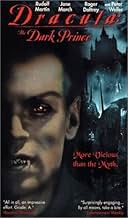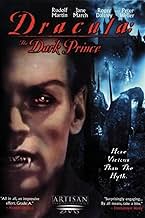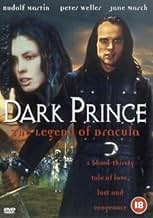IMDb RATING
6.0/10
2.8K
YOUR RATING
The dramatized story of Dracula, looking at the historic events rather than the Hollywood version.The dramatized story of Dracula, looking at the historic events rather than the Hollywood version.The dramatized story of Dracula, looking at the historic events rather than the Hollywood version.
- Awards
- 1 nomination total
- Director
- Writer
- All cast & crew
- Production, box office & more at IMDbPro
Featured reviews
Good try at a Bio of Vlad Tepes but too many historical mistakes of his life. Filmed in Sighisoara Vlad's actual birthplace but they mention that he was born somewhere else. You can actual see the building he was born in, Sighisoara is a beautiful medieval town so filming there was a great idea. Though alot of mistakes were made it was still a good story and a well done film.
I have always been fascinated by the history of Vlad Dracula, and am glad that someone finally decided to make a film of this fascinating man. Low budget or not, this film is a great interpretation of the history of the legend.
Not your typical Dracula film, this film tells the story of the real Dracula, who inspired the story by Bram Stoker. It shows his birth, to his reign as prince of Romania, to his death. Some of the scenes are based on fact, others, I'm sure, were written just for the film. I have quite a few historical books about the man, and yes, the atrocities shown in this movie, were in fact done by the man.
The film was filmed in Romania and Hungary, so that does add to the realism of the story. The film is low budget, but even so, the sword fights had excellent choreography, and the special effects were above par for the budget. The only drawback for me was the length. Only 90 minutes.
All in all, this movie is worth a rental by both historical buffs, and horror fans. Hopefully someone will make a big screen version of this story one day. It sure does deserve one.
Not your typical Dracula film, this film tells the story of the real Dracula, who inspired the story by Bram Stoker. It shows his birth, to his reign as prince of Romania, to his death. Some of the scenes are based on fact, others, I'm sure, were written just for the film. I have quite a few historical books about the man, and yes, the atrocities shown in this movie, were in fact done by the man.
The film was filmed in Romania and Hungary, so that does add to the realism of the story. The film is low budget, but even so, the sword fights had excellent choreography, and the special effects were above par for the budget. The only drawback for me was the length. Only 90 minutes.
All in all, this movie is worth a rental by both historical buffs, and horror fans. Hopefully someone will make a big screen version of this story one day. It sure does deserve one.
Some things...
1) Dracula's first wife (whose name has never been historically documented other than known to be a Transylvanian noblewoman) committed suicide in 1462, not 1464, when Dracula was already imprisoned by the King of Hungary anyway. Not sure why the film changed this, really.
2) The impalings... aren't accurate. The oiled stake is put in the buttocks and slowly moves out through the mouth. This takes days, the impalee dying a slow death. We don't see any actual impalings during the movie save one, and the guy slides down the stake like it's a flag pole.
3) While not necessarily portrayed as a nice guy, I was expecting a bit more brutality. Much of Vlad Tepes' acts are brushed aside in the framing story of Dracula being interrogated by the priests in 1476 as "stories" by Dracula himself and this just seems like a kind of cop-out. I realize we don't need to see Dracula cutting the breasts off of women and such, but there was PLENTY of more hard-hitting material that could have been put in there. Example: instead of Dracula just closing the doors and executing the boyars like he does in the film, wouldn't it be far more effective cinematically to follow what *really* happened and show Dracula and his men dragging the boyars to go and build (by themselves) Castle Dracula, which took years and basically worked the lot of them to death? Also would have been effective to show the scene of Dracula rounding up all the homeless and beggars into the grand hall, then having his men burn it to the ground. The only real story of Dracula that was included was the one with the golden goblet that wasn't touched by anyone... that's about it.
4) I realize it was done for dramatic purposes, but the film kept sticking Dracula's broth Radu in places/times he simply wasn't. Dracula was killed in 1476 by a man (a Turk) disguised as one of his own guards... in a MARSH somewhat near Snagov, not inside Snagov Chapel.
5) The ending is neither here or there... I'd rather they didn't go that route, but then the end of Vlad's life is a bit anti-climactic.
1) Dracula's first wife (whose name has never been historically documented other than known to be a Transylvanian noblewoman) committed suicide in 1462, not 1464, when Dracula was already imprisoned by the King of Hungary anyway. Not sure why the film changed this, really.
2) The impalings... aren't accurate. The oiled stake is put in the buttocks and slowly moves out through the mouth. This takes days, the impalee dying a slow death. We don't see any actual impalings during the movie save one, and the guy slides down the stake like it's a flag pole.
3) While not necessarily portrayed as a nice guy, I was expecting a bit more brutality. Much of Vlad Tepes' acts are brushed aside in the framing story of Dracula being interrogated by the priests in 1476 as "stories" by Dracula himself and this just seems like a kind of cop-out. I realize we don't need to see Dracula cutting the breasts off of women and such, but there was PLENTY of more hard-hitting material that could have been put in there. Example: instead of Dracula just closing the doors and executing the boyars like he does in the film, wouldn't it be far more effective cinematically to follow what *really* happened and show Dracula and his men dragging the boyars to go and build (by themselves) Castle Dracula, which took years and basically worked the lot of them to death? Also would have been effective to show the scene of Dracula rounding up all the homeless and beggars into the grand hall, then having his men burn it to the ground. The only real story of Dracula that was included was the one with the golden goblet that wasn't touched by anyone... that's about it.
4) I realize it was done for dramatic purposes, but the film kept sticking Dracula's broth Radu in places/times he simply wasn't. Dracula was killed in 1476 by a man (a Turk) disguised as one of his own guards... in a MARSH somewhat near Snagov, not inside Snagov Chapel.
5) The ending is neither here or there... I'd rather they didn't go that route, but then the end of Vlad's life is a bit anti-climactic.
This film is based on the known history of Vlad Tepes (Vlad the Impaler), son of Dracul (the name means either devil or dragon), who has come to be known through Bram Stoker's famous novel as Dracula. The film begins with Vlad confessing his life story to Greek Orthodox priests. He is caught in the weblike power struggles involving the Roman Catholic Church, the Greek Orthodox Church, Hungary, and the Moslem Turks. In the midst of all this, he tries to do what is best for his homeland.
The film illustrates the origins of the Dracula myth: blood drinking, impaling with stakes, fear of mirrors, rebellion against religion, and the doom of eternal life because he is cursed to be welcome in neither heaven nor hell. Vlad is presented historically as a Robin Hood freedom fighter, a George Washington of Romania, and a man who tries to bring peace and justice to his troubled land. Some see him as a Messiah while others believe he is the Anti-Christ. In some ways, Vlad can be viewed as a 15th Century Godfather.
The plot unfolds slowly but the movie is nicely photographed and well acted. Vlad himself is played as a moody, brooding, dark figure who easily gives life to the many legends that have become attached to his name.
This is another very well-executed TV-movie and is definitely worth watching. The fact that it premiered on Halloween night is appropriate because the atmosphere is quite spooky.
The film illustrates the origins of the Dracula myth: blood drinking, impaling with stakes, fear of mirrors, rebellion against religion, and the doom of eternal life because he is cursed to be welcome in neither heaven nor hell. Vlad is presented historically as a Robin Hood freedom fighter, a George Washington of Romania, and a man who tries to bring peace and justice to his troubled land. Some see him as a Messiah while others believe he is the Anti-Christ. In some ways, Vlad can be viewed as a 15th Century Godfather.
The plot unfolds slowly but the movie is nicely photographed and well acted. Vlad himself is played as a moody, brooding, dark figure who easily gives life to the many legends that have become attached to his name.
This is another very well-executed TV-movie and is definitely worth watching. The fact that it premiered on Halloween night is appropriate because the atmosphere is quite spooky.
The biggest reason why i love this movie so much because im from Balkan and Romania is my neighboring country and they are also Orthodox like myself. But thats not the only reason of course, movie was just wonderful (even thought it had low budget), Rudolph Martin was also great, location and music everything, I just loved it so much. The only problem i saw was the cover of the movie. Its very misleading, because this movie is definitely not about bloodsucking creatures, its about a Prince who would do anything to bring justice to his people and his country, even become a catholic, and his actions were seen as fight against God and his soul was condemned forever. Its a must see, especially for the people of Orthodox orgins.
Did you know
- TriviaIn 2000, to promote the film's premiere, USA Network held a sweepstakes contest with a grand prize of $5,000 to the lucky person who can correctly identify five myths of Dracula as depicted in this film.
- Quotes
Radu: You are going to kill me, aren't you?
Vlad Dracula: You are a traitor to your people. You betrayed our father!
Radu: I never betrayed our father! Besides, if it weren't for me, you'd still be in that Turk prison.
Vlad Dracula: You had that much influence over the Sultan? Even as a boy?
Radu: Especially as a boy.
- SoundtracksLa Scarpa My Faict Mal
Written by Bernard Solomon (as J. Baird) and Frank Gari (as F. Gari)
Details
Contribute to this page
Suggest an edit or add missing content



























